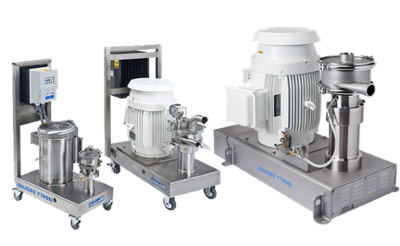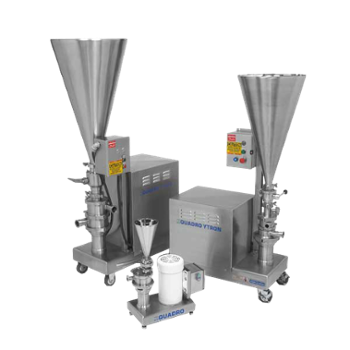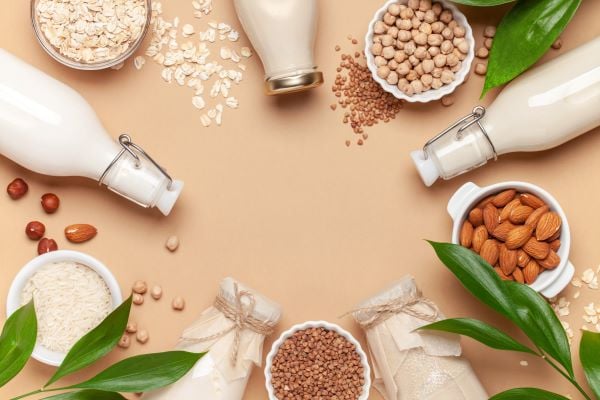What are plant-based milks?
There is a growing demand for dairy-free and vegan alternatives to milk. In fact, plant-based products now make up 10% of the total milk market. From well-known alternatives such as almond and oat milk, to relative newcomers such as pea and barley milk, consumer demand has never been greater.
There are a number of reasons for this sudden surge in popularity. It is in part due to the adoption of vegetarian and vegan diets across the population. Improved awareness of lactose intolerance has also driven demand for alternatives.
A further factor is the public perception that plant milk has a lower carbon footprint than dairy-based products. Whatever people’s personal reasons for choosing plant milk, non-dairy milk processing has become a growth industry that can’t be ignored.
Although the end product is similar, each plant-based milk involves different raw materials. A variety of nuts, seeds, grains and legumes are used, each requiring different processing methods to achieve a smooth milk-like result. So let’s take a look at plant-based milk processing in more detail.
Non-dairy milk manufacturing: an overview
The mixing of the raw ingredients is handled using one of two methods:
- Wet milling – using raw ingredients without any prior handling
- Powder dispersion – using pre-milled and pre-sized ingredients
Most plant-based milks will have additional ingredients added in such as stabilizers, thickeners, and gums. Effective mixing processes will evenly incorporate these additions with the raw ingredients.
Filtration is often required as a final step to remove any impurities, lumps and larger particles. The better the mixer, the less filtration will be required.
In general, manufacturers are often looking to reach a smooth mouthfeel for the consumer. Some specific products aim for a grainier consistency.
What processing methods are used?
The manufacturing processes differ according to the raw materials being handled:
Nuts
The most popular nut milks are made from almonds and cashews, with hazelnut, and macadamia nuts also used. Manufacturers will either use whole nuts, often roasted or blanched to improve blending or process the nuts into pastes, powders or flours. Pastes must be fine to give a smooth ‘in the mouth’ texture. The milk is usually strained to remove larger particles and reduce any grittiness of the finished product.
Coconuts
Coconut milk is taken from dehusked and deskinned kernels. To achieve a smooth finish, the flesh of the fruit is mechanically grated before diluting with water and pressing. It is then finely filtered to remove large particles. Recombined coconut milk can also be made from concentrated or powdered coconut milk or from coconut water.
Grains
Oat milk is the most popular of the grain-based milks. The oats are soaked and blended with water, and oil is often added to enhance the texture, before filtering for a smooth result. Rice milk is manufactured by blending rice syrup with water, before adding the thickening ingredients of rice flour and starch.
Legumes
Legume milks include soya and, more recently, pea milk. Soya milk can be made from whole beans, which are processed by soaking and grinding. Alternatively, soya milk can be manufactured from powders and flour.
Seeds
Sunflower and hemp seed milks have become increasingly popular. The whole seeds need to be soaked in water before wet grinding. The milk is then strained through a fine filter to remove larger particles for a smooth final result.
What are the challenges?
The manufacturer is aiming for a lean process, high yields, less waste, and better product. However, the challenges of processing non-dairy milk products can mean that ingredients are not fully incorporated and are lost in the filtration process. Let’s take a look at some of the challenges involved:
Whole ingredients
When manufacturing from whole ingredients, multiple pieces of equipment are often required to complete the process. It can require several separate processes to effectively grind, disperse and reduce the particle size of the finished product, adding to the overall cost.
Pastes
Pastes can be challenging to store, with solids settling out while the product is in storage. This can cause complications with the transfer of the full quantity, leading to the wastage of the raw materials.
Particle size
A smooth mouthfeel is the aim of most manufacturers of plant-based milks. Soya flours and protein powders may have a larger particle size than deemed acceptable for this smooth finish. Dispersion of the powdered raw material may not be completed to a sufficient level to reduce graininess.
Filtering
Particle size can also be an issue in the filtering process. When the particle size is not reduced sufficiently, a large quantity of the raw material used will be filtered out. This leads to high levels of raw ingredients being wasted.
Separation
In nut and seed milks particularly, oil separation can appear in the final product. This tends to occur if there has been insufficient mixing in earlier stages of the process.
Thickening agents
The addition of thickening agents can add further complications. If the agents are not completely dispersed, they can form lumps. These agglomerates will be filtered out, resulting in additional raw materials being wasted. Problems such as this can arise when the grinding equipment used is unsuitable for dispersing thickening and stabilizing agents.
Hygiene
The equipment typically used for grinding is often hard to clean, leading to hygiene issues.
Solution 1: Wet milling
Quadro HV High Shear Mixer Homogenizer
For wet milling of plant-based milks, the Quadro HV delivers high-shear mixing results without the need for high-pressure processing of raw ingredients. It provides more process shear energy than a conventional rotor-stator mill, and is ideally suited for processing the smooth emulsions required for non-dairy milks.

Why choose the Quadro HV for plant-based milk processing?
The Quadro HV tackles the many challenges of plant-based milk production, offering an efficient and cost-effective solution.
Higher shear energy – The Quadro HV produces more than 55 times the high shear energy of a conventional rotor-stator mill. This results in finer size reduction and reduced processing time. It will ensure that multiple raw ingredients are incorporated successfully and not lost in the filtration process.
Production capacity and efficiency - When used for inline continuous operations such as plant-based milk production, the HV offers a significant increase in production capacity. More efficient processing will save both time and money in the long term.
Time savings – The Quadro HV delivers a reduced process time of raw ingredients, with single-pass, on-target results.
Reduced maintenance – The reliable and robust machine design features easy-to-clean, sanitary construction. The highly sanitary design is ideal for plant-based milk processing.
Solution 2: Powder dispersion
Quadro Ytron ZC Powder Disperser
The ZC was specifically designed for the incorporation of difficult-to-disperse ingredients, such as those used in plant-based milk production. It has been uniquely engineered to incorporate and disperse even the most difficult-to-wet powders and thickening agents into a smooth, liquid stream in a single pass.

Why choose the Quadro Ytron ZC for non-dairy milk processing?
Superior product quality – The high-speed inline disperser handles powders and thickening agents to produce results that are completely free of lumps and “fish eyes”. Batch-to-batch product consistency is significantly improved.
Maximized product yield - Since the powder is completely hydrated and free of lumps after a single pass, product yield is maximized. The wastage often experienced in the filtration stage of the process is reduced or eliminated.
Time savings – The high-speed dispersion and hydration of the powders and pre-milled ingredients will result in batch time reductions of up to 90%.
Sanitary design – The easy-to-clean design meets 3-A® Sanitary Standards, making it the perfect choice for food processing.
Need help with Plant Based Milk Manufacturing?
Our experienced application team is on hand to assist with your equipment selection and material handling needs. Please get in touch via our contact form and share your project needs. If you want to test any of our equipment in our state-of-the-art facility then please contact us via our Technology Centre form.
Related Reading:


